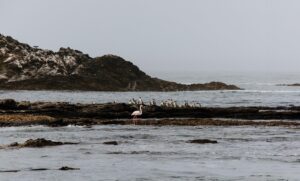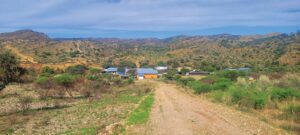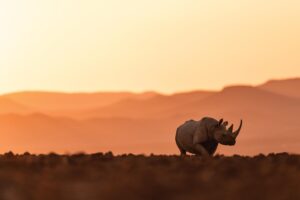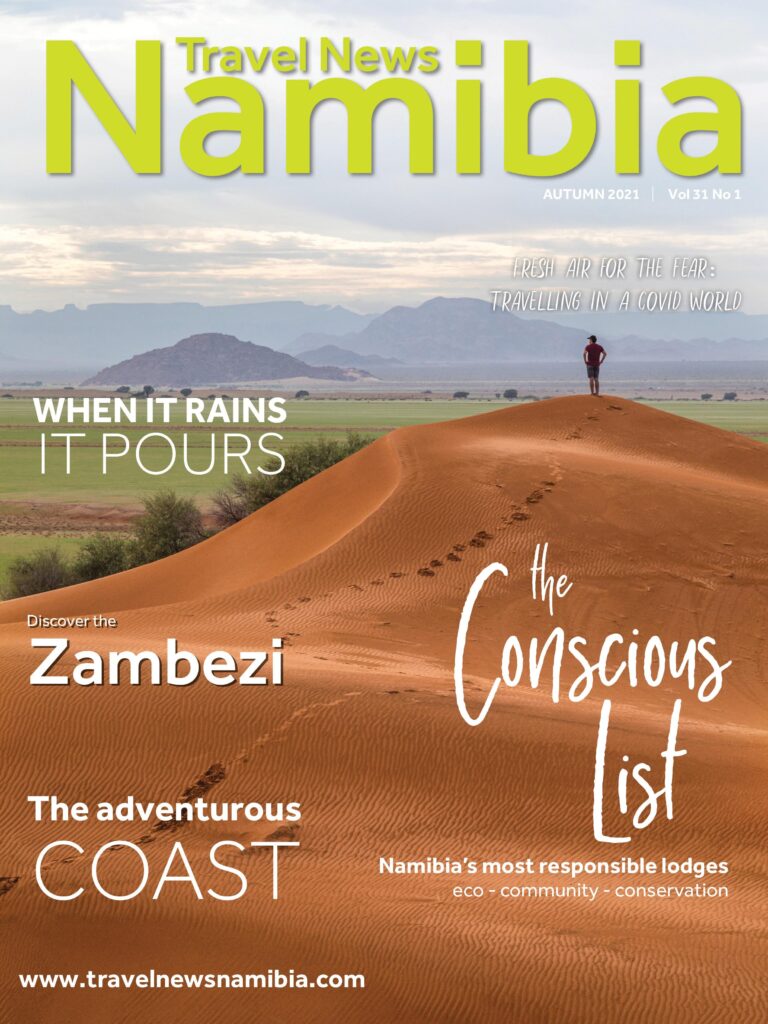
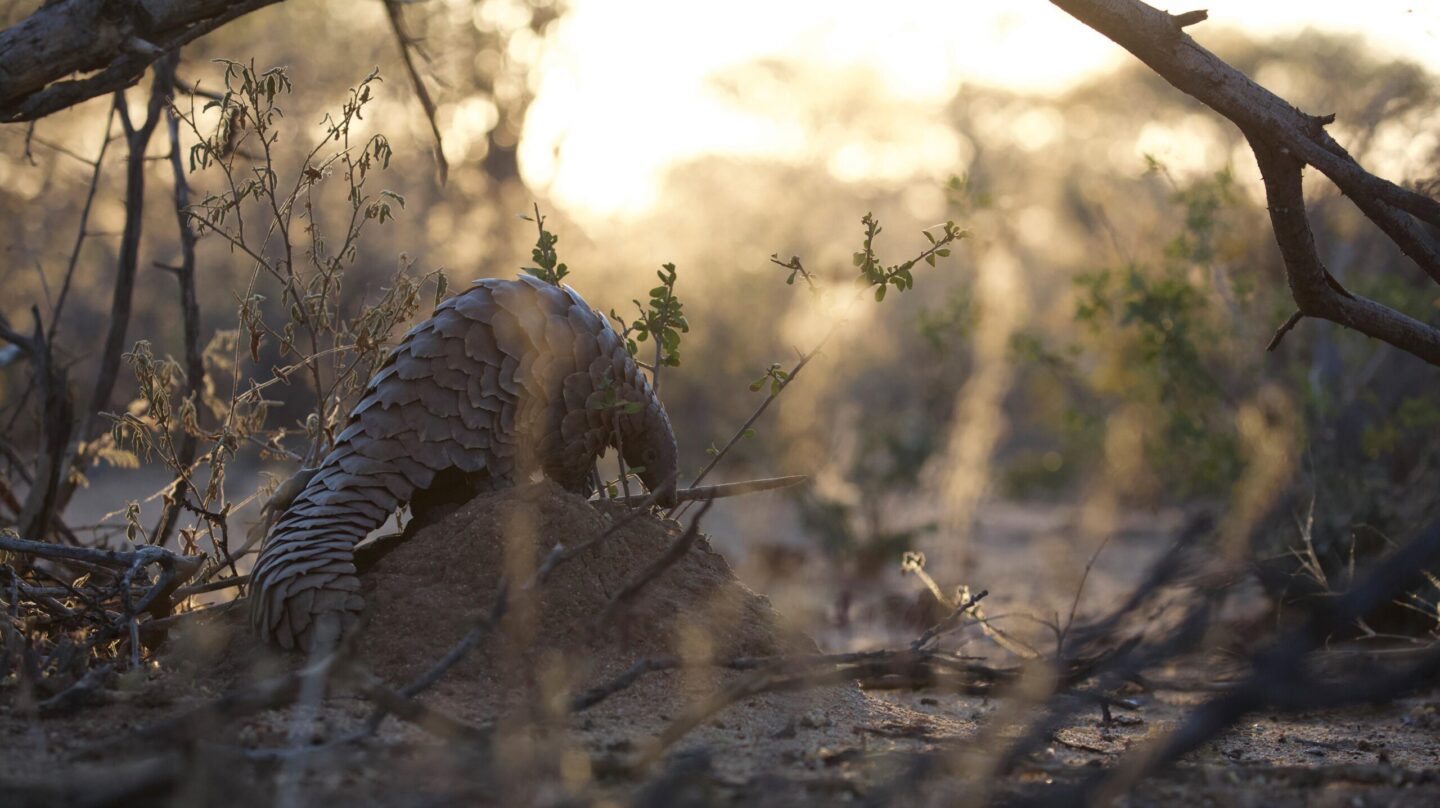
An elusive creature:
the pangolin
Pangolin species around the world are under severe threat due to the demand for their scales and meat, mainly by consumers in China and Vietnam. In Namibia, the Temminck’s ground pangolin occurs across much of the country (excluding the extremely arid west and south) and is increasingly targeted by poachers, yet its status and ecological requirements are poorly understood.
Text Kelsey Prediger | Photographs Kelsey Prediger
From the Autumn 2021 issue
Pangolins, also known as scaly anteaters, are covered in scales which consist of keratin. Despite their primeval or reptilian-like appearance, they are in fact placental mammals. The first fossil records originate from over 60 million years ago. Despite this long history of survival, pangolins were the most trafficked mammal worldwide in 2014. Two years later, all eight species were given the highest level of protection listed under CITES (the Convention on International Trade of Endangered Species), Appendix I (CITES, 2016). Appendix I status prohibits the international trade of said species as they are deemed to be threatened with extinction.
The eight species of pangolin are split between Asia and Africa. All pangolins belong to the genus Manis in the family Manidae, which is the only family within the order Pholidota. Although pangolins share similar characteristics with Xenarthrans (anteaters, armadillos and sloths), they are in fact more closely related to the order Carnivora (cats, dogs, bears, etc.). The traits they share are an example of convergent evolution rather than relatedness.
Listed below are the species and their IUCN status:
ASIAN PANGOLINS:
| Chinese pangolin | Manis pentadactyla | Critically Endangered |
| Sunda pangolin | Manis javanica | Critically Endangered |
| Indian pangolin | Manis crassicaudata | Endangered |
| Philippine pangolin | Manis culionensis | Critically Endangered |
AFRICAN PANGOLINS:
| Cape or Temminck’s Ground pangolin | Smutsia temminckii | Vulnerable |
| White-bellied or Tree pangolin | Phataginus tricuspis | Endangered |
| Giant Ground pangolin | Smutsia gigantea | Endangered |
| Black-bellied or Long-tailed pangolin | Phataginus tetradactyla | Vulnerable |
As most species are predominantly nocturnal, they spend their days resting in burrows or trees and become active when conditions are ideal for them. The Temminck’s ground pangolin does not dig its own burrows but prefers aardvark burrows and moves to new ones often.
All pangolins are myrmecophagous, which means they exclusively eat ants and termites. They don’t have particularly good vision, but they have an amazing sense of smell with which they are able to sniff out ant and termite nests. They use their long sticky tongue, which is as long as the body and extremely flexible, to collect their prey. Pangolins do not have teeth but rather a strong, gizzard-like stomach with keratinous spines which aid in grinding up the ants Listed below are the species and their IUCN status: and termites. While feeding they also ingest small stones and sand which also help grind up their prey.
Pangolins are important for the ecosystem because they eat a large number of pests. It is estimated that each consumes so many ants and termites, it would provide enough food for 30 cattle or 430 springbok per year. Preliminary research in Namibia demonstrates a preference for very specific species, and since mostly they are harvesting ants and termites, the pangolins’ presence reduces damage to crops and organic matter which serves as food for livestock and wildlife.
Pangolins are solitary animals. Usually they are only found together when fighting over territory, when mating or rearing their pups. It is believed that there is a mating season and pups are born early on in the rainy season. The gestation period can range from 65 – 139 days, depending on the species. Offspring will stay with their mother for about the first year and then disperses.
Other than trafficking, threats to pangolin are vehicle accidents, electrocution on electric fencing, habitat loss and poaching for bushmeat, traditional medicine and spiritual rituals. It is estimated that one pangolin per year dies for every 11 km of low- lying electrical fencing. They don’t have many natural predators as their scales are very protective when rolled into a tight ball. Pangolin have been witnessed being played with by leopards and lions alike, but have escaped unharmed.
PANGOLINS IN NAMIBIA
The only pangolin species that occurs in southern Africa, the Temminck’s ground pangolin (Smutsia temminckii), is adapted to live in an arid environment with a minimum of 250 mm of
annual rainfall. It is the most studied of the African species but research was only conducted in South Africa and Zimbabwe predominantly from the 1990s onward. Kelsey Prediger, founder of the Pangolin Conservation and Research Foundation (PCRF), focused her MSc thesis on Pangolin Ecology in Namibia. It is the first in-depth glance in Namibia into the secretive life of pangolin and the data gathered provides valuable details to help conserve the species.
In recent years in Namibia, the annual figure of cases registered for pangolin specific crimes has surpassed that of rhino and elephant. In 2019 alone, the authorities confiscated 123 pangolins of which only 49 were still alive. Namibia increased the penalty for pangolin possession or trafficking in 2017, to a fine of up to N$ 25 million and up to 25 years in prison, the same as for rhino trafficking.
The protection and conservation of pangolins in Namibia is a complex and urgent matter that requires linked-up collaboration from many organisations. In response, the Ministry of Environment, Forestry and Tourism (MEFT) identified the need for a Namibian Pangolin Working Group (NPWG) as part of Namibia’s five-year national security strategy to address wildlife crime. Established in April 2020, the NPWG was tasked with coordinating and driving pangolin conservation and research in Namibia.
The current priorities of the NPWG are:
- Develop a concise National Conservation Management Plan for pangolin;
- Prepare guidelines and protocols for the handling of confiscated pangolins by first responders, getting them quickly into rehabilitation and veterinary care, and the procedures for selecting good release sites;
- Guide priority research to better understand key areas specifically related to pangolin conservation, diet, status and release;
- Raise awareness and help educate target groups about pangolins, particularly their ecological role and importance to ecosystem functioning;
- Promote international collaboration and information sharing.
“The protection and conservation of pangolins in Namibia is a complex and urgent matter that requires linked-up collaboration from many organisations”
Pangolins seized from illegal traffickers are often emaciated, dehydrated and traumatised. These animals require first aid from the time of seizure and specialised care until their release to give them the greatest chances of survival. A key part of the NPWG’s National Pangolin Conservation Management Plan establishes clear guidelines for pangolin transport, care and rehabilitation along with contact lists for veterinary clinics and other relevant organisations.
Priority research conducted by NPWG members is focused on topics that will improve the chances of survival for trafficked pangolins and assist those working on wildlife crime to understand local threats to the species. A survey of public sightings combined with suitability models has become the first reliable national distribution map for pangolin. You can contribute your sightings here to assist us in this process. All sightings are kept strictly confidential. Combining this knowledge of pangolin distribution and known hotspots for trafficking, we can identify and select potential release sites in each region of Namibia. Other important aspects of pangolin releases are the survival rate of released individuals and their impact on the resident population at the release sites. TNN
You can help pangolin by spreading awareness about their plight! Share this article and other pangolin posts online to gain a wider reach. Please contact the MEFT wildlife crime hotline at 55555 if you have any information on illegal capture, trade or trafficking in pangolins or their parts.


